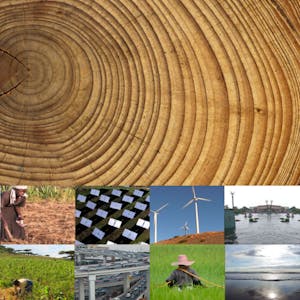Description
Each part of the world faces specific vulnerabilities to climate change and has different opportunities to mitigate the effects and build resilience in the 21st century. With the ratification of the Paris Agreement, many countries have acceded to act in combatting climate change. Indeed, without climate action, decades of sustainable development is at risk, thus making this a ‘make or break’ point in time. Showcasing the most recent scientific evidence, explaining the different regional impacts and divulging climate action strategies, along with interactive tools such as a Carbon Footprint Tracker and (I) NDC Platform, this MOOC provides some opportunities, where you can take action on climate change. About the Course This action-oriented MOOC gives you the opportunity to learn about regional climate change impacts and sector-specific strategies to increase resilience and move towards a low-carbon future. You will have the opportunity to explore these issues in depth and tailor your learning experience for one or more of the following regions: • Latin America and Caribbean • Sub-Saharan Africa • Middle East and North Africa • Eastern Europe and Central Asia • East Asia and Pacific • South Asia In this endeavor, the MOOC brings together renowned scientists and policymakers to provide a synthesis of the most recent scientific evidence on climate change, regional low emissions and climate resilient development strategies across sectors. A team of expert Instructors will lead discussions around the Paris Agreement, reflections from COP22 and the progress on Nationally Determined Contributions (NDCs). Course Syllabus Overview ‘From Climate Science to Action’ is divided into four weeks. The first two weeks will provide a comprehensive overview of the scientific evidence for climate change, followed by region-specific insights on the impacts of a warmer world in the 21st century. The last two weeks will focus on action strategies that are being undertaken in different regions and countries to meet the climate challenge, and how you as an individual can take action to avoid a warmer world! Week 1: Climate Change in the 21st Century • Historical and projected observed changes in the climate system, leading up to the end of the 21st century • The potential of Intended Nationally Determined Contributions (INDCs) submitted at COP 21 from 187 countries to induce climate action • Trends in climate change impacts, including loss of Arctic sea ice, melting glaciers, increased heat waves and extreme temperatures, and drought and aridity • Possible responses from natural systems, explaining how warming could result in sea-level rise, heat waves and extreme temperatures, and ocean acidification Week 2: Sectoral and Regional Impacts • Impacts on key development sectors—from warming above pre-industrial temperatures and projected climate trends—across each of the world’s regions • Sectoral impacts focusing on agricultural production, water resources, ecosystem services, and coastal vulnerability for affected populations • Importance of risks with the potential to reverse hard-won development gains and potentially trap millions in poverty, illustrating the need for urgent action now Week 3: From Science to Action on Climate Change • Region-specific discussions on mitigation actions needed to reduce emissions while decreasing vulnerability to climate change impacts through adaptation and by building climate resilience • Perspectives from regional experts on their experiences in strategies and actions proposed in each region to help transition towards a low-emissions, climate-resilient development path • Discussions on the progress of the Nationally Determined Contributions (NDCs), outcomes of the Paris Agreement and reflections from the Conference of Parties (COP)22 Week 4: What You Can Do • Transformative impact of day-to-day changes when brought to a global scale • The rationale for acting now, acting together and acting differently • Examples and expected benefits of mitigation and adaptation policies, considering both contributions to global emission reductions and local development opportunities In addition to the core resources and assignments, you may choose to go further, engaging in fun optional exercises, networking, discussion, and diving deeper into our rich selection of supplemental resources. You will have the opportunity to explore these issues in depth and tailor your learning experience for one or more of the following regions: • Latin America and Caribbean • Sub-Saharan Africa • Middle East and North Africa • Eastern Europe and Central Asia • East Asia and Pacific • South Asia Course Format This MOOC has a week-by-week structure, with resources, activities and exercises for you to engage in during each of the four weeks of the course. Each week, you will find a variety of course material, including: • Interactive video talks by renowned climate scientists and practitioners • Interactive tools: the Carbon ...
